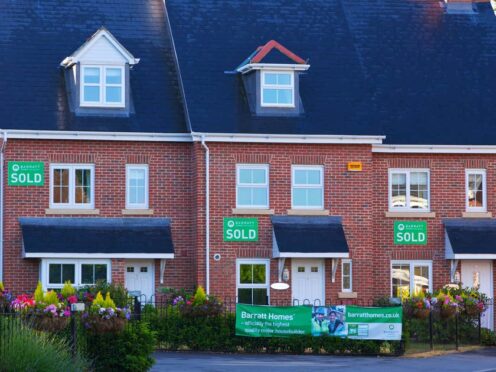Barratt Developments has said it will build fewer homes next year despite respite from soaring building costs and Labour’s pledge to cut planning red tape.
The group said it expects new home completions to drop by up to another 7% in its new financial year, having plunged by nearly a fifth in the year to June 30, as high mortgage costs hold back demand.
Barratt – which recently agreed a £2.5 billion deal to buy rival Redrow – said home completions are set to fall to between 13,000 and 13,500 in 2024-25, down from 14,004 in the past year.
It said this came as the “macro backdrop remains challenging, particularly demand sensitivity to current mortgage pricing and availability”.
But Barratt forecasts that build cost inflation will finally “abate” over the year ahead and remain broadly flat, having jumped higher in recent years.
It also said that underlying pre-tax profits for the year to June 30 will be “slightly” better than expected.
Shares fell 3% on the gloomy home completions outlook.
The figures come as the sector is hoping for a boost to housebuilding under the new Labour Government.
New chancellor Rachel Reeves laid out her plans on Monday to address the nation’s new homes shortage, revealing aims for mandatory housebuilding targets for local councils and to scrap the onshore wind farm ban.
Barratt said: “We welcome the new Government’s urgency and focus on housebuilding and reform of the planning system as key to both unlocking economic growth and tackling the chronic undersupply of new homes.
“We look forward to working with Government and wider stakeholders to address supply side constraints and deliver the new homes, of all tenures, the country needs.”
Barratt said while it expects to see a reduction in average new homes sales outlets in the year to June 2025, it is “confident” over a return to growth in the following financial year.
The group is also hoping to secure competition watchdog approval for its deal with Redrow.
The two housebuilders agreed an all-share deal in February which would see them become Barratt Redrow, creating a group expected to build about 23,000 homes a year and make more than £7 billion in revenue.
But the Competition and Markets Authority (CMA) last month kicked off a formal investigation into whether the deal will hurt competition.
It comes after the CMA announced an initial probe in March.
The watchdog will report its findings by August 8.
